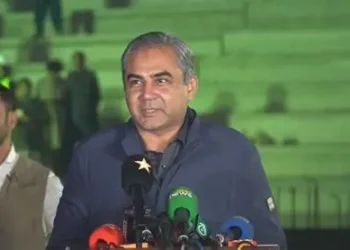Lord’s, London:
At the end of a dramatic Test match at Lord’s, the image of Ben Stokes and Ravindra Jadeja sharing a quiet embrace captured the spirit of a hard-fought series. Two of the finest modern all-rounders, battered and drained after five grueling days, acknowledged each other not just as opponents, but as warriors who gave everything to pull their teams across the line.
The final day at Lord’s saw India fall short by 22 runs, bowled out for 170 while chasing 193. It was not quite a heartbreak of epic proportions, but it was one of those defeats that will sting India deeply. With the win, England took a 2-1 lead in the five-match series, even as each game so far has gone deep into the fifth day. It’s a series of narrow margins, but India have repeatedly found themselves on the wrong side of them.
Stats Say One Story, Scoreboard Another
What makes India’s position puzzling is that the numbers overwhelmingly support them. Across the three Tests:
-
India have scored more runs: 2295 to England’s 1945
-
Averaged more per wicket: 40.98 vs 35.36
-
Hit more centuries: 8 to 5
-
Taken the same number of wickets: 55 each
-
At a better bowling average: 36.05 vs England’s 42.60
-
Claimed more five-wicket hauls: 4 to 0
Yet, India trail the series 1-2. And the reason lies in the smaller moments the unforced errors, the marginal calls, and the quiet slips in concentration.
Lord’s: Not One Collapse, But Many Small Cuts
India began the final day at 58/4, needing just 135 runs with six wickets in hand. On a pitch that had begun to misbehave, those runs looked achievable until England’s pacers made sure they weren’t.
Rishabh Pant, KL Rahul, and Nitish Reddy all fell to top-quality deliveries early in the day. Pant had briefly counter-attacked, despite nursing an injured hand, but was undone by a Jofra Archer peach that sent his off stump cartwheeling. Rahul was trapped LBW by Stokes, with the decision overturned on review. Reddy hung on before nicking off to Woakes just before lunch. India collapsed to 82/7, and the game had all but slipped.
But unlike previous collapses, this wasn’t a batting meltdown. This was England squeezing India out of the game, and it was a result of positions India had put themselves in earlier.
Pant’s Run-Out: The Defining Moment
The turning point arguably came two days earlier Day 3, just before lunch. Pant and Rahul had built a 141-run stand, absorbing pressure and starting to take control. But in the final over of the session, Pant attempted a risky single to get Rahul back on strike, only to be run out by a brilliant direct hit from Stokes. Pant was dismissed for 74.
That single moment changed the complexion of the match. India, instead of pushing towards a 450-plus first innings total, folded for 387. England matched that score, and the Test was back on level ground but with India now slated to bat last on a deteriorating surface.
Shubman Gill later admitted that the run-out was decisive. “It wasn’t about personal milestones. It was an error in judgement,” he said. “Rishabh called for the run after hitting the ball, and unfortunately, it was the danger end.”
‘Pant run out the turning point’ – Gill#ENGvIND pic.twitter.com/xayqJ86Bub
— ESPNcricinfo (@ESPNcricinfo) July 15, 2025
Also Read: Gavaskar Slams Indian Batting After Lord’s Collapse: “Jadeja Could Have…”
Fielding, Ball Change, and Fortune
India’s fielding also played a part in the unraveling. On Day 2, Jasprit Bumrah had sparked a mini-collapse, reducing England from 251/4 to 271/7. But Jamie Smith, dropped by Rahul at slip on 5, went on to score 56. His 84-run stand with Brydon Carse brought England right back in.
A changed ball further complicated matters. After the original ball lost shape, India requested a replacement. But the new ball swung 2.6 times less, giving England’s lower order breathing room. These subtle variables fielding lapses, ball behaviour added up.
Missed Chances and Misfortune
India’s bowlers were consistent, but sometimes just unlucky. Ben Duckett and Zak Crawley both had among the highest false-shot percentages in the match 40% and 44.8% respectively yet both survived long enough to chip in with 20+ runs. In a match decided by 22 runs, those mini-innings proved crucial.
In the final innings, Jadeja fought valiantly, even as wickets tumbled around him. His 73 held the innings together, but once the final two wickets fell shortly after lunch on Day 5, India were left ruing yet another missed opportunity.
Despite being statistically superior, India have let key moments slip in all three Tests. A poor session at Headingley. A late collapse at Edgbaston. And now, a run-out and fielding lapses at Lord’s. Each mistake chipped away at a potential lead.
As the series moves toward its final two matches, India have to find a way to not just win moments, but string them together. The numbers may suggest domination, but unless the team tightens its grip in clutch situations, the scoreboard will keep telling a different story.













